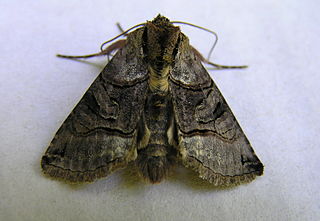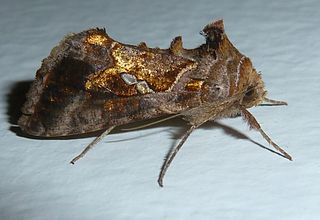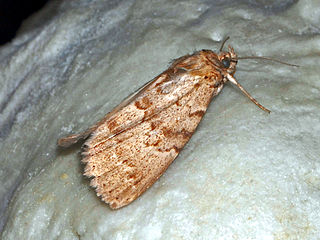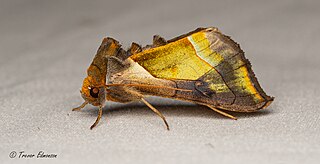
Plusiinae is a smallish subfamily of the moth family Noctuidae. As the Noctuidae appear to be a paraphyletic assemblage, the Plusiinae may eventually be raised to family status.

The Abrostolini are a small tribe of moths in the Plusiinae subfamily, consisting of the genera Abrostola and Mouralia.

The tomato looper or golden twin-spot moth(Chrysodeixis chalcites) is a moth of the family Noctuidae, subfamily Plusiinae. It mainly lives in southern Europe, the Levant and tropical Africa, but can be seen migrating across much of Europe. In 2013, it was spotted in Canada. It is an important horticultural pest in New Zealand.

Thysanoplusia daubei is a moth of the family Noctuidae. It is found in North and East Africa, Southern Europe, Arabia, Turkey, Southern Iran to the Himalayas, India, Indochina, China, Japan and Taiwan.

Apopestes spectrum is a species of moth in the family Erebidae first described by Eugenius Johann Christoph Esper in 1787.

Dichagyris flavina is a moth of the family Noctuidae. It is found in most of the Balkans and through large parts of the Near East and Middle East. It has been recorded from Bulgaria, Romania, North Macedonia, Greece, Turkey, southern Russia, Armenia, Syria, Lebanon, Israel, Jordan, Iran and Iraq.
Noctua tertia is a moth of the family Noctuidae. It is found in the Balkans, Turkey and Iran. It has recently been recorded from forests in Upper Galilee in Israel.
Shargacucullia strigicosta is a moth of the family Noctuidae. The species was first described by Boursin in 1940. It is found in Iraq and the Sinai in Egypt. Recently it has also been recorded from Israel and some areas of Turkey, Azerbaijan and Iran.
Calocucullia celsiae is a moth of the family Noctuidae. The species was first described by Gottlieb August Wilhelm Herrich-Schäffer in 1850. It is found from the Balkans to Turkey, northern Iraq, Armenia, Iran, Israel, Jordan and Lebanon.
Pamparama acuta is a moth of the family Noctuidae first described by Christian Friedrich Freyer in 1838. It is found in Asia Minor and the Near East.
Abrostola clarissa is a species of moth of the family Noctuidae. It is widespread from Turkey to south-western Iran, the Caucasian Region and northern Iraq. In the Levant it is recorded from Syria, Lebanon and Israel.
Euchalcia aureolineata is a moth of the family Noctuidae. It has been recorded from Syria and Israel.
Euchalcia augusta is a moth of the family Noctuidae. It is found from the Taurus Mountains to Lake Van in Turkey. In the Levant it has been recorded from Syria and Israel.
Euchalcia maria is a moth of the family Noctuidae. It is endemic of the Levant. It is found from south-eastern Turkey to Israel.
Euchalcia paulina is a moth of the family Noctuidae. It is endemic to the Levant. It is found from Jordan to Israel.

Allagrapha aerea, the unspotted looper moth or copper looper moth, is a moth of the family Noctuidae. The species was first described by Jacob Hübner in 1803. It is found in eastern North America from southern Ontario to the Florida Panhandle and west to western Nebraska.

Diachrysia balluca, commonly known as the green-patched looper or hologram moth, is a moth of the family Noctuidae. The species was first described by scientific illustrator Carl Geyer in 1832.
Polychrysia morigera, the disjunct looper, is a moth of the family Noctuidae. The species was first described by Henry Edwards in 1886. In the east of North America, it is found in the Mississippi, Missouri, and Ohio river valleys from Pennsylvania to Tennessee. In the Rocky Mountains it is found from Montana to Colorado and on the west coast it occurs from Oregon to northern California. It is the rarest of the North American Plusiinae species.

Autographa buraetica is a moth of the family Noctuidae. It is found in north and north-eastern Germany, Scandinavia, Poland, Russia, Mongolia, Siberia, the Ussuri region, Korea and Japan. It has recently been recorded from Austria. In North America, it is found in Alaska, the Yukon, the Northwest Territories and British Columbia.

Plusidia cheiranthi is a moth of the family Noctuidae. It is found in Southern and Eastern Europe, in Turkey, Siberia and eastwards to the Pacific Ocean.









